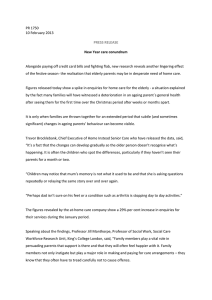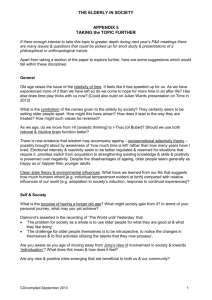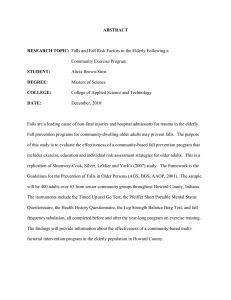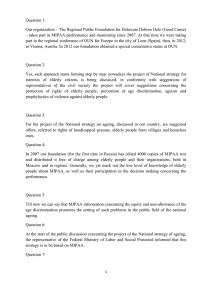Ageing, Medicine and Society
advertisement
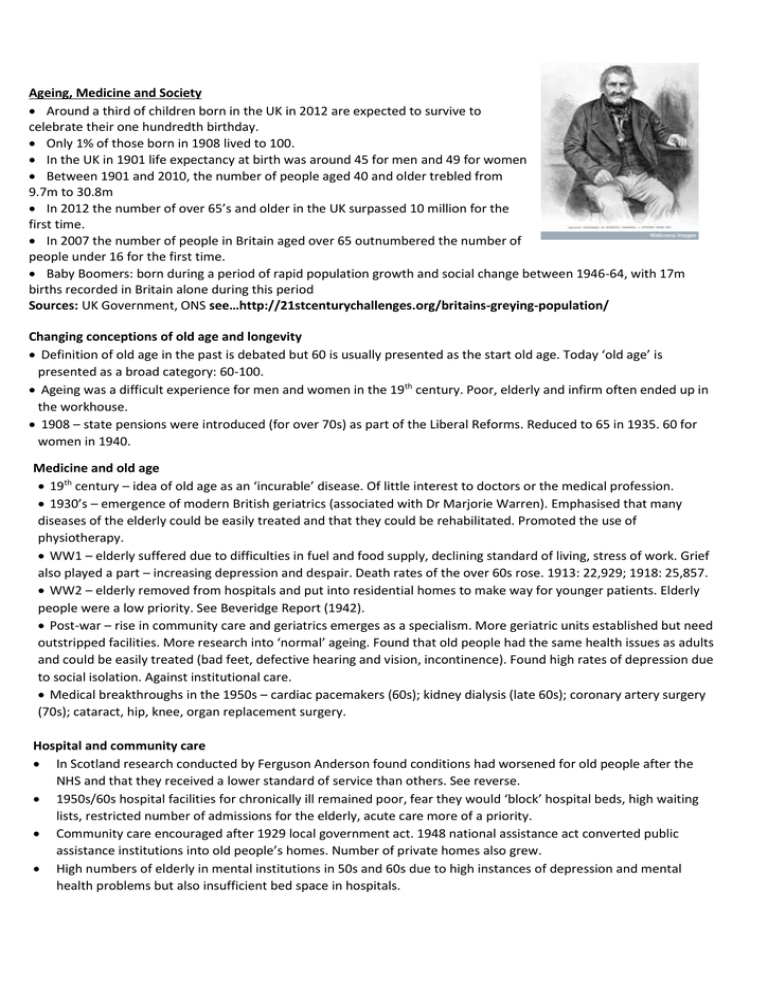
Ageing, Medicine and Society Around a third of children born in the UK in 2012 are expected to survive to celebrate their one hundredth birthday. Only 1% of those born in 1908 lived to 100. In the UK in 1901 life expectancy at birth was around 45 for men and 49 for women Between 1901 and 2010, the number of people aged 40 and older trebled from 9.7m to 30.8m In 2012 the number of over 65’s and older in the UK surpassed 10 million for the first time. In 2007 the number of people in Britain aged over 65 outnumbered the number of people under 16 for the first time. Baby Boomers: born during a period of rapid population growth and social change between 1946-64, with 17m births recorded in Britain alone during this period Sources: UK Government, ONS see…http://21stcenturychallenges.org/britains-greying-population/ Changing conceptions of old age and longevity Definition of old age in the past is debated but 60 is usually presented as the start old age. Today ‘old age’ is presented as a broad category: 60-100. Ageing was a difficult experience for men and women in the 19th century. Poor, elderly and infirm often ended up in the workhouse. 1908 – state pensions were introduced (for over 70s) as part of the Liberal Reforms. Reduced to 65 in 1935. 60 for women in 1940. Medicine and old age 19th century – idea of old age as an ‘incurable’ disease. Of little interest to doctors or the medical profession. 1930’s – emergence of modern British geriatrics (associated with Dr Marjorie Warren). Emphasised that many diseases of the elderly could be easily treated and that they could be rehabilitated. Promoted the use of physiotherapy. WW1 – elderly suffered due to difficulties in fuel and food supply, declining standard of living, stress of work. Grief also played a part – increasing depression and despair. Death rates of the over 60s rose. 1913: 22,929; 1918: 25,857. WW2 – elderly removed from hospitals and put into residential homes to make way for younger patients. Elderly people were a low priority. See Beveridge Report (1942). Post-war – rise in community care and geriatrics emerges as a specialism. More geriatric units established but need outstripped facilities. More research into ‘normal’ ageing. Found that old people had the same health issues as adults and could be easily treated (bad feet, defective hearing and vision, incontinence). Found high rates of depression due to social isolation. Against institutional care. Medical breakthroughs in the 1950s – cardiac pacemakers (60s); kidney dialysis (late 60s); coronary artery surgery (70s); cataract, hip, knee, organ replacement surgery. Hospital and community care In Scotland research conducted by Ferguson Anderson found conditions had worsened for old people after the NHS and that they received a lower standard of service than others. See reverse. 1950s/60s hospital facilities for chronically ill remained poor, fear they would ‘block’ hospital beds, high waiting lists, restricted number of admissions for the elderly, acute care more of a priority. Community care encouraged after 1929 local government act. 1948 national assistance act converted public assistance institutions into old people’s homes. Number of private homes also grew. High numbers of elderly in mental institutions in 50s and 60s due to high instances of depression and mental health problems but also insufficient bed space in hospitals.


